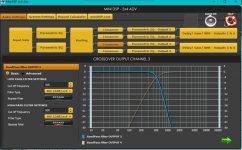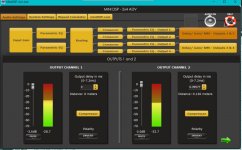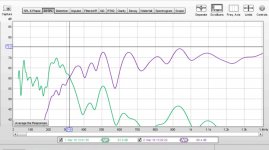The TPA3251 amps have only 22dB of gain (internally fixed and cannot be changed). Your other amps are closer to 27dB to 30dB. You need to use a preamp to drive the 3251’s. Does -8dB less sensitive sound about right?
There is a thing with miniDSP stock gain. There is a small switch inside that lets you set the gain. Change it to max setting. They set it low for measuring loud concert levels.
I forgot about that low gain thing. It works fine once you change it. But that noise should not be there - maybe try a different laptop?
There is a thing with miniDSP stock gain. There is a small switch inside that lets you set the gain. Change it to max setting. They set it low for measuring loud concert levels.
I forgot about that low gain thing. It works fine once you change it. But that noise should not be there - maybe try a different laptop?
Thanks xrk971. That's a great tip about changing the gain in the minidsp. I'll open it up! That said, I'm not talking about an 8dB difference. More like twice that. At least. I don't have the TDA7297's 'opend up' at all. They're barely on. There's all that extra PEQ'ing in the x-o section of the minidsp which may also be sucking out the sound. I'll find that switch and report back.
found it. Two jumpers actually. Can be set to 2.0V or .9V and are set to 2.0 on V2 from the factory. a bit anti-intuitive as it means max input b4 the unit clips. But it does say to set it to .9v if using a preamp, which I am. The manual also says no matter the setting the output limit remains the the same. The result is definitely more volume for me. But string bass and snare drum are now a bit clicky sounding and I'm not sure if it's clipping or I need to re-EQ. I'm guessing it's an EQ problem. Glad to have the extra juice tho. Thanks x as always.
Still listening. The clicks when i started are gone. Must've been a fluke in the first two songs. The volume is good. The uTrynergy's are singing and slamming.
Sounds like the mini DSP is picking up some power noise over USB. I have a USB-USB Connector which has galvanic isolation built in which solves exactly those kond of problems. Where do you live, maybe I can help you out?As soon as you plug a usb cable in it starts generating noise. Like 20% of the sound is a usb storm. Even when not hooked up to the computer, if you power it with the usb cable plugged into a 5V charger let's say, there is a mixmaster sound whenever the music gets quiet. Annoying.
ok, the flag indicates "far away from me" 🙂
But if you run into these kind of problems, I am sure there are some kits for DYI or ready made products in the US... I have these as trouble solver on jobs, sometimes the video/light DMX is interfering with AUdio, because the light guy plugged the VGA Video Output into the PC with the DMX Controller, etc...
But if you run into these kind of problems, I am sure there are some kits for DYI or ready made products in the US... I have these as trouble solver on jobs, sometimes the video/light DMX is interfering with AUdio, because the light guy plugged the VGA Video Output into the PC with the DMX Controller, etc...
Hi Sabbelbacke. Thanks for the suggestion. I believe you have diagnosed my problem correctly, but I'm cheap! Can't defend spending twice as much on an isolator as the minidsp unit itself. It's quiet now unless I have to make adjustments, so I can live with that. BTW, in answer to xrk971, I have used about 4 laptops in this situation. The best I had noise-wise was a tiny Thinkpad, but it had such a slow cpu I had to replace it. Two more larger ThinkPads were too noisy to use. The asus I have now is fast and quiet for the most part. Only the minidsp makes noise when connected to it. Other audio devices are quiet so far.
I don't know about the situation in the US, IN Europe there are a few for around 50 Euros. Surely there are some DIY Solutions.
One possible solution could be: Run the laptop on batterie - remove the power supply... Might help 🙂
One possible solution could be: Run the laptop on batterie - remove the power supply... Might help 🙂
Ha! I've tried the battery b4 but not with the minidsp. It helps alot. Not completely noise free but much better and something I can certainly live with. Thank you Sabbelbacke!
The TDA7297 is 32dB gain. 10dB extra gain is actually a lot and would explain the difference in sensitivity you are seeing. Also, did you set the mode jumpers on the 3E amp to be driven by a single ended amp vs balanced input. If you drive an amp that is expecting balanced signals in with only single ended, that might cause an additional 3dB loss.
The way to tell if it’s the Trynergy that is weak output or the amp that’s weak, take your TDA7297 and put it on the Trynergy driven by miniDSP.
The TDA7297 would be a perfect amp to drive your TC7FD driver. It doesn’t need all the watts that a TPA3251 is capable of putting out and in fact, you run the risk of blowing it out of you get a burp in output from the big amp. The TC7 is only 83.5dB sensitive, and in the horn you will get some increase in sensitivity, but depending on how much you EQ it, you may be back to mid 85dB overall. Your Cornu on the other hand, I forget what drivers you are using, but assuming TC9, that’s 86dB so a bit more already combined with 10dB diff in amplifier gain might account for all of this.
Finally, check your miniDSP overall output volume gain. Is it set at 0dB?
The way to tell if it’s the Trynergy that is weak output or the amp that’s weak, take your TDA7297 and put it on the Trynergy driven by miniDSP.
The TDA7297 would be a perfect amp to drive your TC7FD driver. It doesn’t need all the watts that a TPA3251 is capable of putting out and in fact, you run the risk of blowing it out of you get a burp in output from the big amp. The TC7 is only 83.5dB sensitive, and in the horn you will get some increase in sensitivity, but depending on how much you EQ it, you may be back to mid 85dB overall. Your Cornu on the other hand, I forget what drivers you are using, but assuming TC9, that’s 86dB so a bit more already combined with 10dB diff in amplifier gain might account for all of this.
Finally, check your miniDSP overall output volume gain. Is it set at 0dB?
Last edited:
Thanks X. My 3E amps are both set for the single ended input. Really, switching the jumpers on the minidsp to 0.9V input pretty much solved the volume mystery. before I hooked up the TPA3251's I was using two TDA7297 amps to run the whole Trynergy and it sounded good. I was surprised tho when i switched to the 3E amps since they're supposed to be multiple times more powerful and there was no increase in volume. The gain level explains alot of it. On the minidsp I have the woofers in each output turned down about 3dB otherwise they overpower the highs.
Looks like you are on top of it now. When you get a chance and have a good microphone - try the Harsch XO. It make the sounds really snappy. Unless you are running a 1st order transient perfect XO already. The Harsch will allow a 4th order roll off on the woofer to clean them up a lot yet still enable a quasi transient perfect response.
S. Harsch XO
S. Harsch XO
I tried to set up the system with the Harsch crossover. Each step of the minidsp has confused me, then it sinks in after a while. I looked at ur link and did my best but the whole time wasn't sure if what I was doing was right. Anyway I took a couple of dozen readings from about 0.7 to 0.3 ms output delay on the tweeter with it inverted. No matter what u type in, the software defaults to a preset number but they are all approximately 1/100 second apart. It seemed that 0.39577ms was a bit lower at x-o point than all the others so I left it there. Then started listening to music again. It's all subjective but it seems that the lower-mid bass is cleaner now. And the imaging/staging is remarkably better. Or I drank too much moonshine. The Lincoln Center Jazz Orchestra filled the room and I could pick out all the individual instruments. On a Stanley Clarke studio recording people were spread out way wider than the speakers themselves, the band was cooking, and at the end a voice commented on the great performance- and it came from behind me! Made me jump a little. But I was so happy after the experience I could only grin and agree. Here are acouple of screen grabs of my settings; let me know if something seems off. Thanks X!
Attachments
Nice work Bonjonno. Did you ever get a microphone? Please show your measured crossover plot. Woofer only, tweeter only, and combined. Despite setting the electrical crossover at 500Hz, the electro acoustic crossover (where the microphone measures as crossing) is the true crossover point that matters. If it is 500Hz, the time period for that is 1/500Hz or 2millisecond. Take half of that and the delay should be 1millisecond. However, your tweeter is already set back because it is in the horn throat. The other delay assumes they are on flat baffle. Hence, your 0.39ms might be perfect.
The way to check is look at the measured response. A correct Harsch will show the combined response to have a slight dip (<1dB) in the bass right under the XO point. And the step response will show a right triangle on top of a “hill” or “bread loaf”.
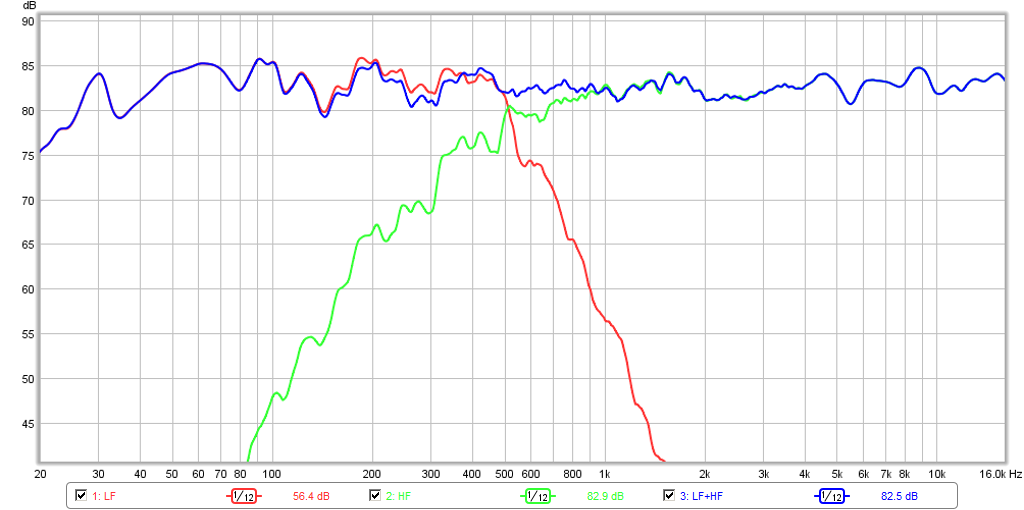
The way to check is look at the measured response. A correct Harsch will show the combined response to have a slight dip (<1dB) in the bass right under the XO point. And the step response will show a right triangle on top of a “hill” or “bread loaf”.

OK I'll get on that. I've always had a calibrated mic. It's my studio friend's sonarworks XREF20. Very similar looking to the behringer or parts express one with XLR out. I don't think my graphs were as smooth as yours or as high dB but I'll give it a shot and report back.
I need to take a break. No matter what I try I keep getting similar results that don't appear anything like yours. The way it's currently setup with the XO point to be 500, the graphs I get show a XO point of 318Hz or so. If I raise the XO point in mini dsp as high as 1000Hz, the graph still shows the XO at ~ 345Hz. and the rest of the reponse looks terribly ragged, yet it sounds good. Even tho the mic is calibrated, the only way to get it into my laptop is thru a digital mixer, out of its headphone jack and into the laptop's mic input and thru its soundcard. I think there's something ugly going on along the way...
Attachments
You maybe too far from the speaker. Take the measurement at 0.5m and use frequency dependent window (FDW) 6 cycles. This will remove effects of external reflections.
So first thing before imposing filters for LP or HP is to apply PEQ gently (broad Q and only -gain) to flatten the response.
Then apply the electrical filter to achieve a measured -24dB/oct slope in the woofer and -18dB/oct Bessel on the high pass.
I think on my Trynergy, I crossed at 350Hz
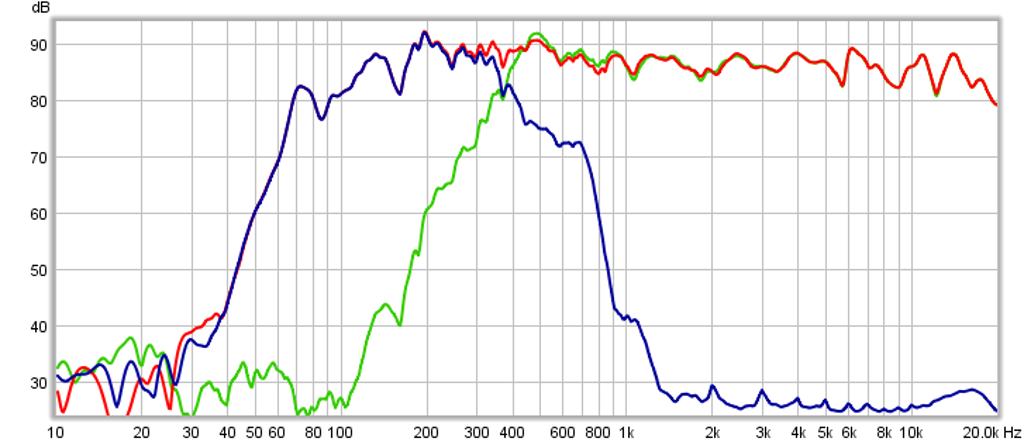
This was before I knew about Harsch XO.
So first thing before imposing filters for LP or HP is to apply PEQ gently (broad Q and only -gain) to flatten the response.
Then apply the electrical filter to achieve a measured -24dB/oct slope in the woofer and -18dB/oct Bessel on the high pass.
I think on my Trynergy, I crossed at 350Hz

This was before I knew about Harsch XO.
Last edited:
OK. Thank you for bearing with me. I had been measuring from one meter so I moved the mic closer. I have always been using FDW. 6 cycles means take 6 readings? When I take multiple readings they all look exactly the same. I imported gentle PEQ filters, all minus gain. Now the crossover may be where I'm screwing up. I thought I could just choose a type and amount in minidsp, but the resulting frequency response looks nothing like what I desire (nothing like ur graph) Do I have to keep trying combinations in minidsp until the resulting measurement looks like what I want?
The actual response is a combination of the electrical filter and the driver’s response to that filter. Hence, why the method I outlined earlier is the only way to do efficiently. It basically lets you simulate the response before you upload it. I know, it’s a complicated process. Takes hours and hours and hundreds of measurements. People who don’t do this don’t realize how much work is on involved for a good textbook response XO.
- Home
- Loudspeakers
- Multi-Way
- Presenting the Trynergy - a full range tractrix synergy.
